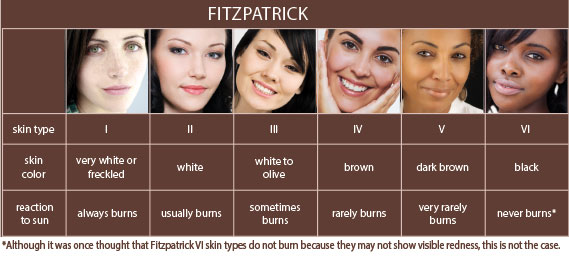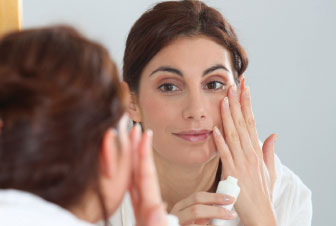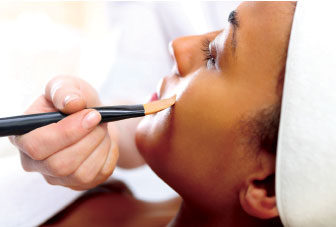There are some skin types, however, that prove to be more complicated to treat than others, including higher Fitzpatrick skin types and sensitive skin. By understanding the physiological differences that exist between the skin of different ethnic backgrounds and identifying the skin conditions common in higher Fitzpatrick skin types that would benefit from exfoliating treatments, it is possible to provide successful, positive treatment outcomes.
 PHYSIOLOGY OF SKIN TYPES
PHYSIOLOGY OF SKIN TYPES
While there are similarities in the physiology of skin types spanning the Fitzpatrick scale, the subtle differences and predisposition to certain conditions lead to changes in the way skin care professionals treat clients from Fitzpatrick I to VI. Skin thickness, sebum production, transepidermal water loss, and the activity of the skin’s melanocytes vary between clients of different ethnicities. These variances alter the available methods for treating each client’s unique skin.
On the high end of the scale, Fitzpatrick skin types IV through VI include those who are typically considered ethnic, although this term is too general in modern times, due to the prevalence of people with mixed hereditary backgrounds.
Those with Fitzpatrick skin types V through VI tend to have a thicker stratum corneum than those that are I through IV (roughly 22 layers versus 17). This denser stratum corneum often leads to impaction and a predisposition to acne breakouts, as a result of increased debris and sebum trapped in the follicles.
Transepidermal water loss is also more common in higher Fitzpatrick skin types, resulting in impaired barrier function. This impaired function often leads to an increased sensitivity to topical stimulation. The more moisture loss present, the more exacerbated the impacted stratum corneum becomes. The dryness that results leads to an increase in sebum production and acne. The higher the grade of acne, the more likely it is that post-inflammatory hyperpigmentation will occur, ultimately complicating treatment for the clinician.
While all Fitzpatrick skin types have the same number of melanocytes present in the skin, the activity of those melanocytes differs. Higher Fitzpatrick skin types have melanosomes with larger melanin granules than those with lighter skin; those granules are evenly dispersed across the skin’s basal layer. This factor leads to melanocytes that are more active and a greater chance of hyperpigmentation.
 COMMON ETHNICSKIN CONDITIONS
COMMON ETHNICSKIN CONDITIONS
Of all the Fitzpatrick skin types, the higher skin types tend to be the most prone to melasma, a pigmentation that usually appears on the face in large, symmetrical, and bilateral patches and has jagged borders on the forehead, cheeks, jawline, and upper lip. While ultraviolet-induced pigmentation can be dispersed and freckled in appearance, melasma presents as distinct patches in specific areas of the face.
Melasma usually appears due to fluctuations in hormones, such as pregnancy, oral contraception, menopause, or hormone replacement therapy. In certain cases, it can also appear due to thyroid dysfunction. Sun exposure and other types of inflammation worsen its appearance and prolong its visibility.
While a hereditary link has been theorized, melasma is a frustrating condition due to the fact that its exact cause has yet to be found and treatment is complicated. What is known is that those with melasma have an increase in the number of melanosomes being formed and distributed among the skin’s keratinocytes and an increased branching of the melancytic dendrites. The more dendrites present, the more opportunity for melanin to disperse, increasing the discoloration in the skin.
In melasma, discoloration is present beneath the skin’s surface with melanocytes that are darker in color and larger in size than those that function normally. Complicating the condition further is the vascularity and redness present in melasma, though it is often difficult to detect in darker skin types.
Due to the hyperactivity of the melanocytes on higher Fitzpatrick skin types, post-inflammatory hyperpigmentation is a constant battle. Small burns, scratches, bug bites, and breakouts all leave brown spots in their wake.
In addition to the predisposition to the aforementioned pigmentation conditions, acne is another concern for the higher Fitzpatrick client. While acne impacts clients across the scale, those with darker complexions often experience the lingering effects of post-inflammatory hyperpigmentation following an acne lesion. Since many of the more aggressive ingredients used to treat acne are contraindicated for higher Fitzpatrick skin types, due to irritation that could potentially cause post-inflammatory hyperpigmentation, treatment is complicated for these clients. In this case, a progressive approach is better than one that is aggressive.
When creating effective treatment strategies for both hyperpigmentation and acne in higher Fitzpatrick skin types, avoiding undue inflammation is key. Employing effective yet gentle products and professional treatments will lead to successful outcomes.
 STRATEGIES FOR HYPERPIGMENTATION TREATMENT
STRATEGIES FOR HYPERPIGMENTATION TREATMENT
The importance of gentle treatment for ethnic skin cannot be overstated. The melanocytes in higher Fitzpatrick skin types are highly responsive while melanin production is accelerated. This acceleration makes low doses of key ingredients, and a slower approach, vital to achieving positive results. Using a combination of anti-inflammatory, daily-care products and superficial, blended chemical peels is a good strategy to reduce redness and the risk for furthering post-inflammatory hyperpigmentation.
Daily Care for Hyperpigmentation
It is critical for the skin care professional to choose topical products with ingredients that interrupt the process of melanogenesis at multiple points and treat this condition without irritation. Options for daily care treatment include hydroquinone; licorice extract; arbutin; kojic, azelaic, lactic, and L-ascorbic acids; retinoids; resorcinol derivatives; and undecylenoyl phenylalanine.
STRATEGIES FOR ACNE TREATMENT
When acne is present in ethnic patients, gentle exfoliation must be utilized to avoid post-inflammatory hyperpigmentation. Many of the same ingredients used in hyperpigmentation treatment may also be utilized in both daily care and professional treatments for acne.
Daily Care for Acne
For exfoliation, alpha hydroxy acids should be employed; control of sebum production without over-drying the skin can be achieved with salicylic acid. This control can also be achieved through the use of oils high in essential fatty acids, borage and grape seeds, and jojoba (in daily regimens). Benzoyl peroxide and licorice extract will help inhibit bacteria growth and reduce inflammation, respectively.
Finally, for all clients, ultraviolet protection is critical. A broad spectrum sunscreen should be considered with zinc oxide for its anti-inflammatory properties and its ability to inhibit melanogenesis.
 HYPERPIGMENTATION AND ACNE TREATMENTS
HYPERPIGMENTATION AND ACNE TREATMENTS
The aforementioned ingredients can be used in treatments that remain at the superficial level, such as chemical peels. Blended peels can be extremely effective at lifting unwanted pigment without causing more inflammation or leading to post-inflammatory hyperpigmentation.
Some of the best exfoliating acids for higher Fitzpatrick skin types are alpha hydroxy, beta hydroxy, and trichloroacetic acids, the Jessner’s solution, and other blended-peel solutions.
Alpha hydroxy acids, used in percentages from 10 to 70, include glycolic and lactic acids. Glycolic acid should be avoided in higher Fitzpatrick skin types. Due to its small molecular structure, it works faster than other acids, causing inflammation and overstimulation as a result. On the other hand, lactic acid is larger in molecule size, penetrating slower and potentially reducing inflammation. Additionally, this ingredient helps hydrate the skin, exfoliate, provide antimicrobial effects, and help reduce pigmentation.
The only beta hydroxy acid currently used in skin care is salicylic acid. This acid is used in percentages from 10 to 50. Salicylic acid is an oil-soluble keratolytic that penetrates through sebum-filled follicles in the skin while also providing anti-inflammatory benefits for all skin types.
Trichloroacetic acid, used in percentages from six to 50, provides peel depths with a wide variety for all skin types; higher Fitzpatrick clients should not be treated with trichloroacetic acid over 10 percent in order to avoid post-inflammatory hyperpigmentation. Trichloroacetic acid peels effectively lift hyperpigmented keratinocytes to improve melasma, post-inflammatory hyperpigmentation, and ultraviolet-induced lesions.
The modified and enhanced Jessner’s solution was the original blended peel solution. It was enhanced in the mid-1990s to include melanogenesis inhibitors, such as hydroquinone and kojic acid. These solutions gently exfoliate the skin and are less likely to irritate and cause post-inflammatory hyperpigmentation when applied by a skin care professional. When fighting either hyperpigmentation or acne, blended peels are a good option for exfoliating ethnic clients.
OPTIMAL RESULTS
Performing a superficial peel once every three weeks is preferred to keep unwanted pigment and P. acnes bacteria from returning. Remind hyperpigmentation clients that pigment may initially darken with treatment, as it is being lifted to the surface of the skin in order to be shed. This is true for acne patients with post-inflammatory hyperpigmentation as well, although this pigment is far more superficial than melasma or sun-induced pigment. Therefore, the lifting is much more rapid.
The importance of daily, broad spectrum protection, especially for those with pigment-related conditions, cannot be overstated. A broad spectrum SPF of at least 30 should be applied year-round, every morning, and throughout the day, in order to best maintain results of a daily skin care regimen and monthly treatments. Advise clients on formulations that have antioxidants to help ward off oxidative damage from exposure to ultraviolet rays.
As always, persistence and patience are key, as exfoliating higher Fitzpatrick skin types must be approached in a progressive, non-aggressive manner. Many clients think that more is better, but when exfoliating darker, more sensitive clients, gentle treatment is critical. Remind clients of this and assure them that, together, the visible results that they seek will eventually be seen.
 Cynthia Price is a board-certified dermatologist and pediatrician practicing out of Scottsdale, Ariz. Price is dedicated to providing excellent, innovative, and compassionate patient care. She specializes in adult, pediatric, surgical, and cosmetic dermatology. Price is a fellow of the American Academy of Dermatology and the American Academy of Pediatrics, as well as a member of the American Society for Dermatologic Surgery, the Society for Pediatric Dermatology, the Women’s Dermatology Society, the Phoenix Dermatology Society, and the American Medical Association.
Cynthia Price is a board-certified dermatologist and pediatrician practicing out of Scottsdale, Ariz. Price is dedicated to providing excellent, innovative, and compassionate patient care. She specializes in adult, pediatric, surgical, and cosmetic dermatology. Price is a fellow of the American Academy of Dermatology and the American Academy of Pediatrics, as well as a member of the American Society for Dermatologic Surgery, the Society for Pediatric Dermatology, the Women’s Dermatology Society, the Phoenix Dermatology Society, and the American Medical Association.


Want to read more?
Subscribe to one of our monthly plans to continue reading this article.